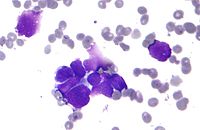
Photo from wikipedia
OBJECTIVE Ectopic Cushing's syndrome (ECS) induced by medullary thyroid cancer (MTC) is rare, and data on clinical characteristics, treatment and outcome are limited. DESIGN Retrospective cohort study in three German… Click to show full abstract
OBJECTIVE Ectopic Cushing's syndrome (ECS) induced by medullary thyroid cancer (MTC) is rare, and data on clinical characteristics, treatment and outcome are limited. DESIGN Retrospective cohort study in three German and one Swiss referral centres. PATIENTS Eleven patients with MTC and occurrence of ECS and 22 matched MTC patients without ECS were included. MEASUREMENTS The primary endpoint of this study was the overall survival (OS) in MTC patients with ECS versus 1:2 matched MTC patients without ECS. RESULTS The median age at diagnosis of ECS was 59 years (range: 35-81) and the median time between initial diagnosis of MTC and diagnosis of ECS was 29 months (range: 0-193). Median serum morning cortisol was 49 µg/dl (range: 17-141, normal range: 6.2-18). Eight (73%) patients received treatment for ECS. Treatment of ECS consisted of bilateral adrenalectomy (BADX) in four (36%) patients and adrenostatic treatment in eight (73%) patients. One patient received treatment with multityrosine kinase inhibitor (MKI) to control hypercortisolism. All patients experienced complete resolution of symptoms of Cushing's syndrome and biochemical control of hypercortisolism. Patients with ECS showed a shorter median OS of 87 months (95% confidence interval [95% CI]: 64-111) than matched controls (190 months, 95% CI: 95-285). Of the nine deaths, four were related to progressive disease (PD). Four patients showed PD as well as complications and comorbidities of hypercortisolism before death. CONCLUSION This study shows that ECS occurs in advanced stage MTC and is associated with a poor prognosis. Adrenostatic treatment and BADX were effective systemic treatment options in patients with MTC and ECS to control their hypercortisolism. MKI treatment achieved complete remission of hypercortisolism and sustained tumour control in one treated case.
Journal Title: Clinical endocrinology
Year Published: 2021
Link to full text (if available)
Share on Social Media: Sign Up to like & get
recommendations!